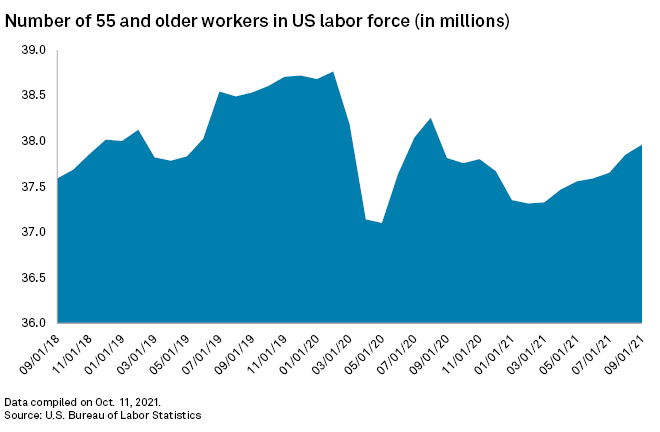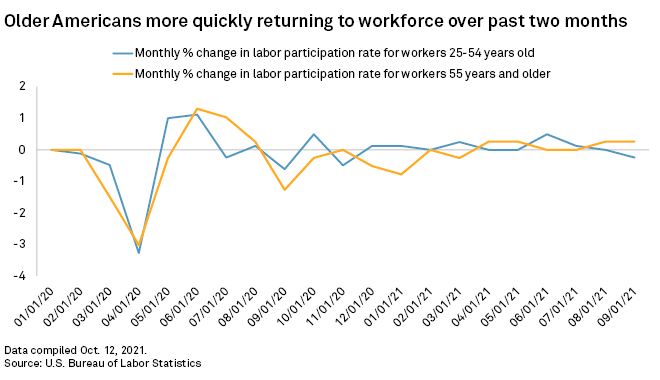The U.S. workforce over the age of 55 is at its largest size in nearly a year, a sign that a pandemic-inspired wave of early retirements appears to have ebbed, economists said.
The labor participation rate — how many workers in the population are in the job market — among those 55 and older rose to a seasonally adjusted 38.6% in September, the highest level since December 2020, according to the U.S. Bureau of Labor Statistics. The unemployment rate for the same group fell to 3.6% in the same month, the lowest since the pandemic began and lower than the 4.8% rate for all workers.

Increased vaccinations were likely the primary driver in the rise in older Americans returning to work, economists said. As of Oct. 11, 56.4% of Americans and 84% of Americans 65 years and over were fully vaccinated against COVID-19, according to the Centers for Disease Control and Prevention.
Grandparents taking on primary child care duties may also be freer to work now that in-person school has returned. In addition, gains in stocks or real estate holdings throughout the pandemic may have kept many older Americans from returning to work and a regular paycheck, economists said.
"I think the health risks and then the financial improvement in terms of the balance sheet were a really potent combination that supported these early retirements," said Sarah House, senior economist with Wells Fargo. "I think while both of those forces are likely to persist in some degree going forward, the degree isn't going to be as dramatic, and therefore, probably the early retirements aren't either."
Early retirement
The recent gains come as the older workforce remains far short of its pre-pandemic levels. An estimated 1.5 million workers retired early during the pandemic, according to Goldman Sachs, and other researchers have pinned that number even higher. Those retirements came voluntarily or followed job losses, economists said.
The number of American workers age 55 and older had been climbing steadily for years before the pandemic hit, reaching an all-time high of nearly 38.8 million in February 2020, according to the BLS. The 55-plus labor force dropped by nearly 1.66 million over the next two months, dropping in May 2020 to its lowest point since March 2018.
The labor participation rate of workers 55 and over fell from 40.3% in February 2020 to 38.5% in April of the same year, compared to the participation rate of workers between ages 25 and 54, which fell from 82.9% to 79.8% over the same time. The April 2020 figure was the pandemic low for the 25-44 group, however, and rose to 81.6% in September 2021.

During much of that period, the participation rate continued to fall for workers over 55, dropping to as low as 38.2% in March 2021.
With inflation running hot, many older Americans, keenly familiar with runaway inflation in the 1970s and 1980s, may be eager to return to work in anticipation of a stagnant economy. The consumer price index, a key measure of inflation, rose 5.4% year over year in September.
"You might have some workers thinking, well, maybe I'm not quite as confident that my retirement balances will get me through the costs I'll have going forward," said Wells Fargo's House.
Cloudy outlook
A stronger labor market is enticing potential retirees to keep working, said Gregory Daco, chief U.S. economist with Oxford Economics. At least two other factors are also contributing.
"The fact that the COVID crisis led to an important outflow of early retirees means that there are going to be fewer going forward. Third, some early retirees are returning to the workforce," Daco said.
It could take at least three years for the level of older workers in the U.S. labor force to return to pre-pandemic levels if current trends continue, said Owen Davis, a research associate with The New School's Schwartz Center for Economic Policy Analysis. Still, a full recovery for this group of workers is far from certain.
"In general, older workers take longer to recover from unemployment, and long unemployment durations raise the odds of retirement," Davis said. "It may be that favorable trends for unemployed older workers continue, and most of these workers find jobs. But we don't know at the moment."



